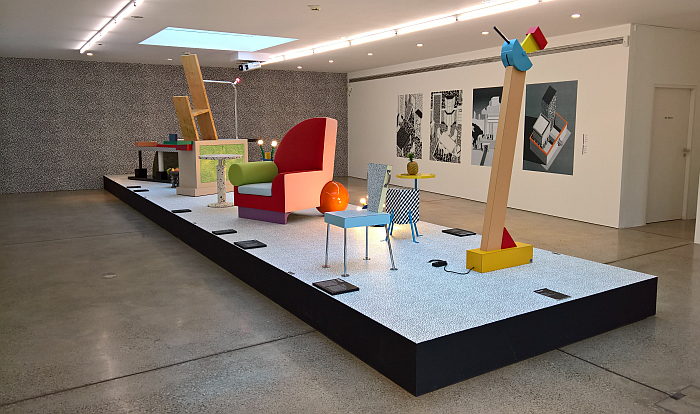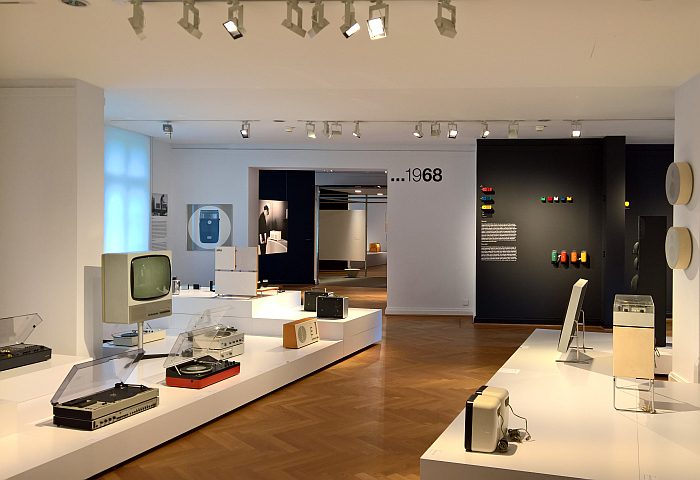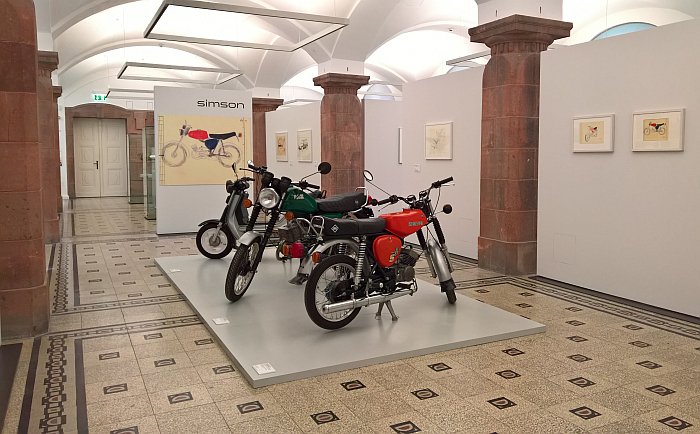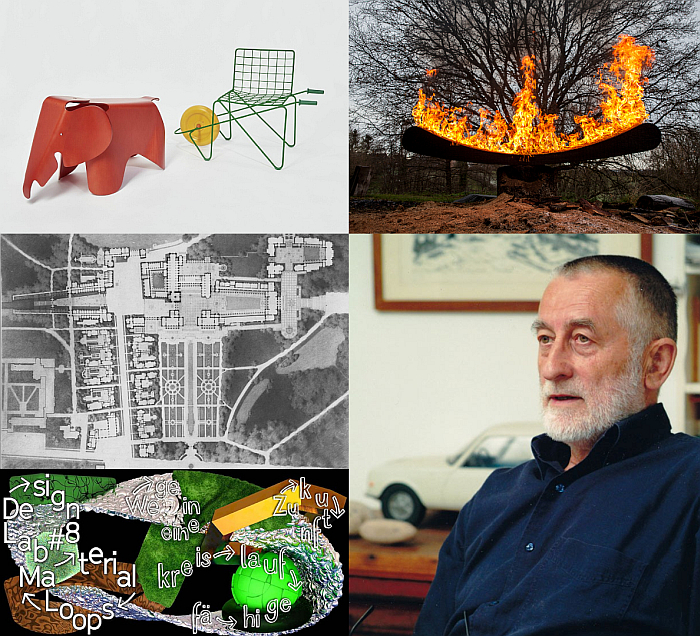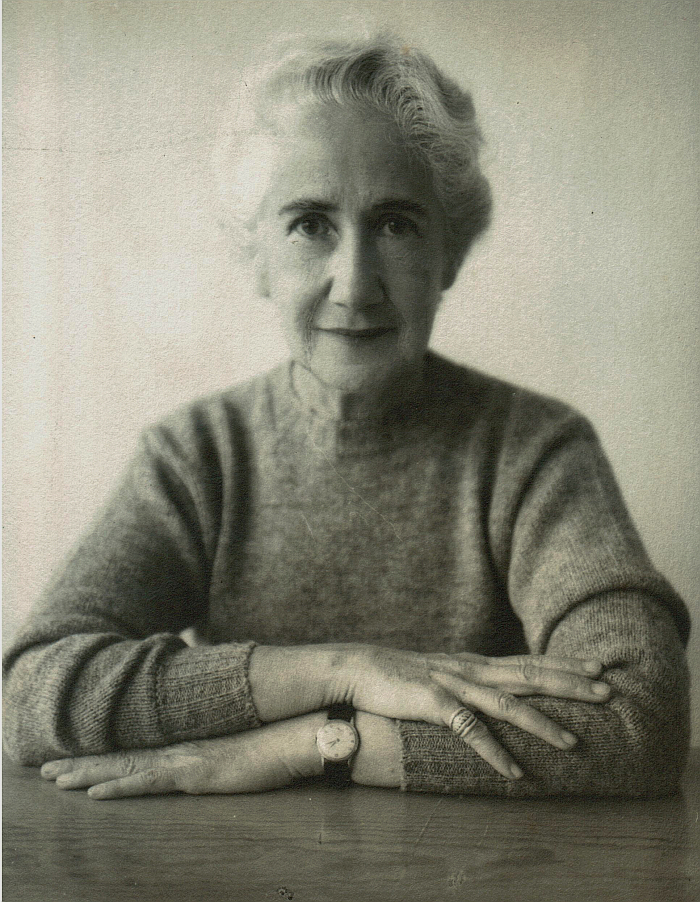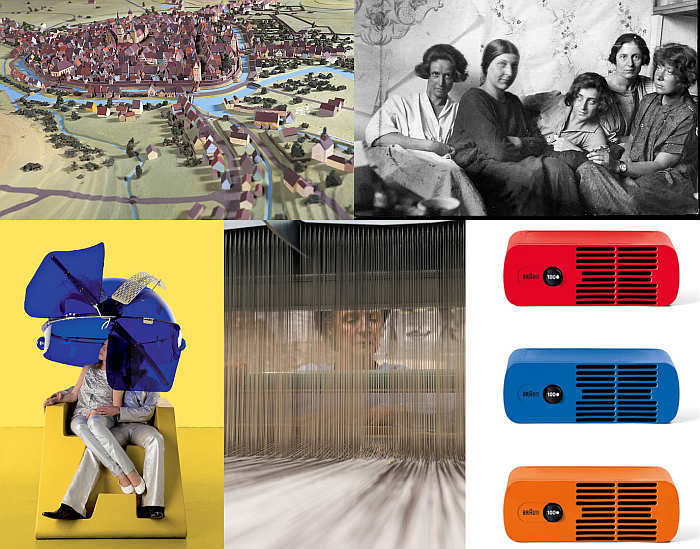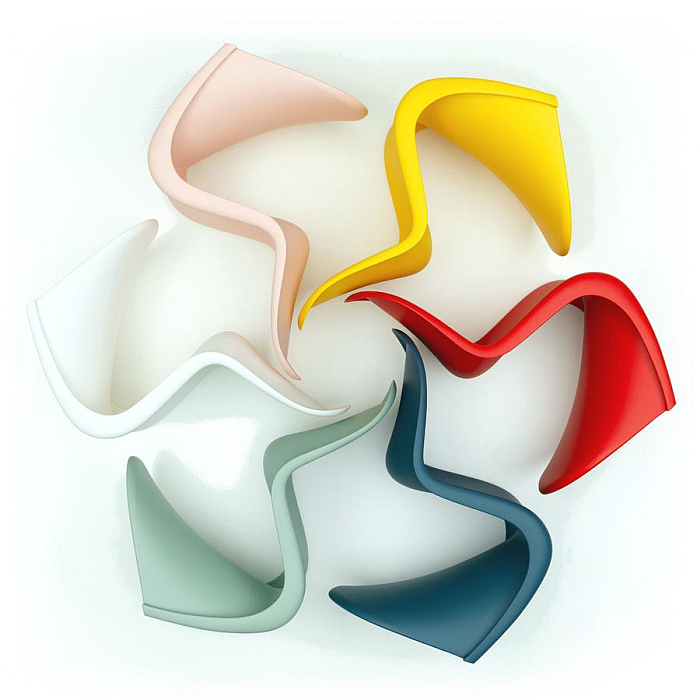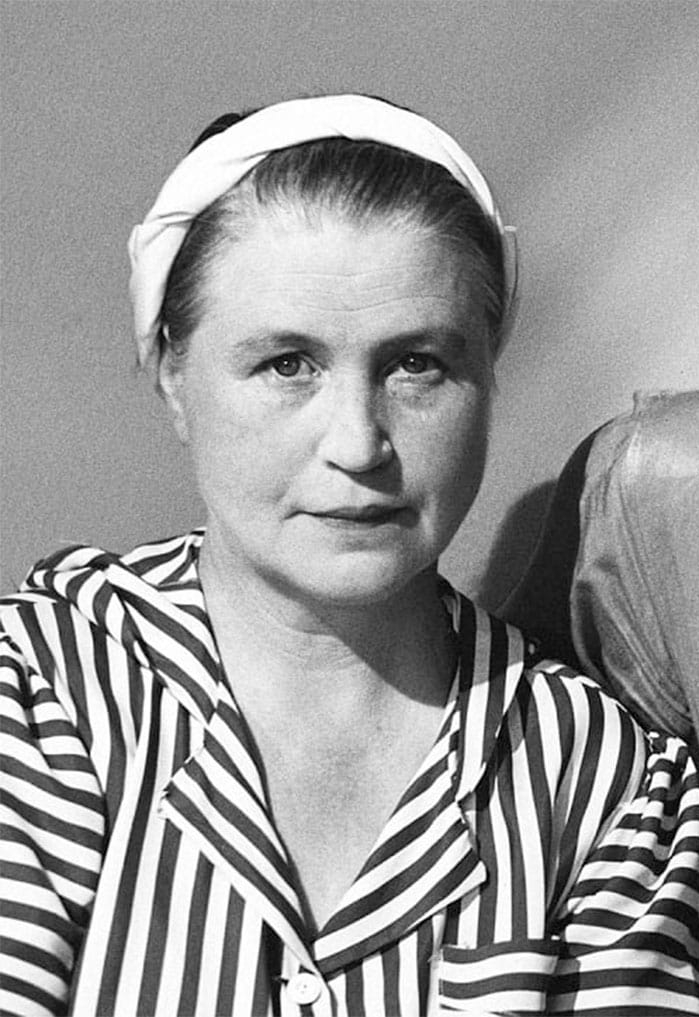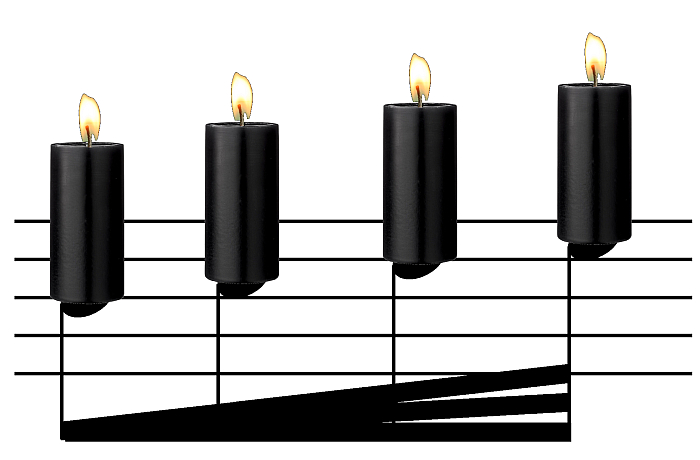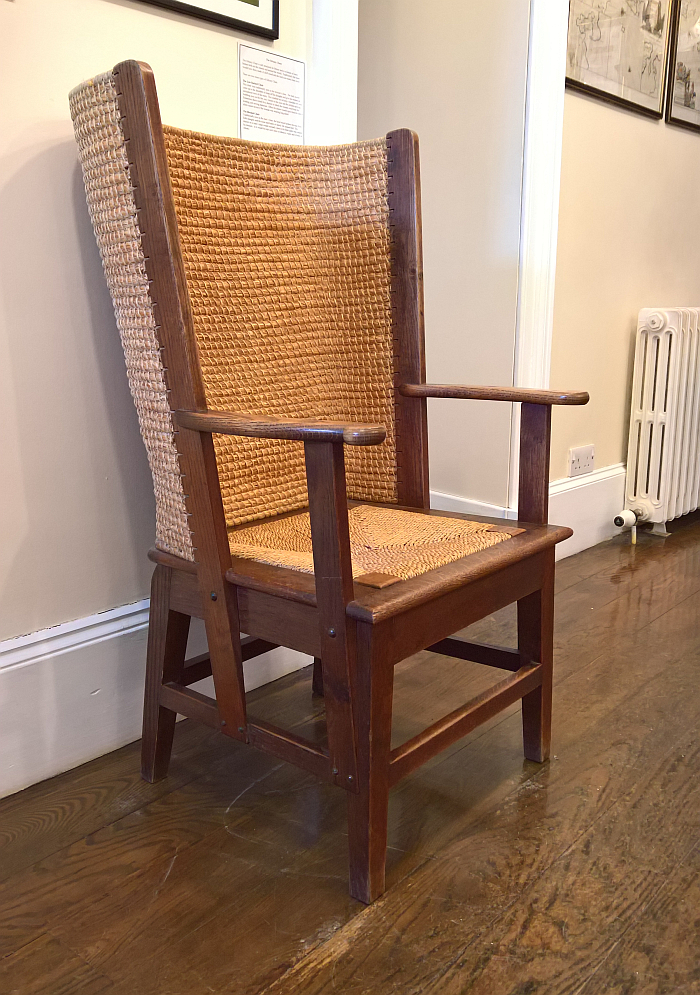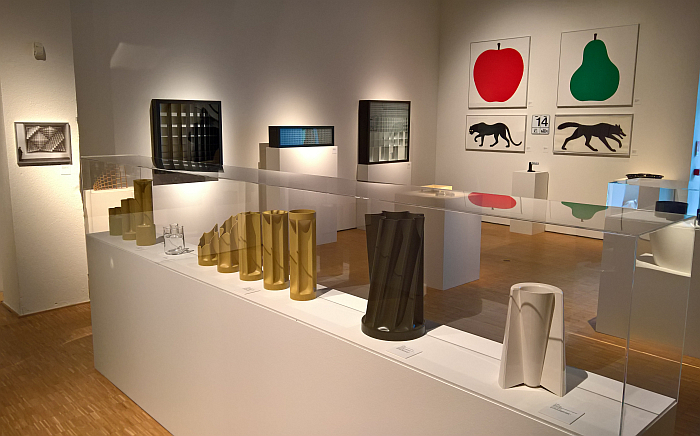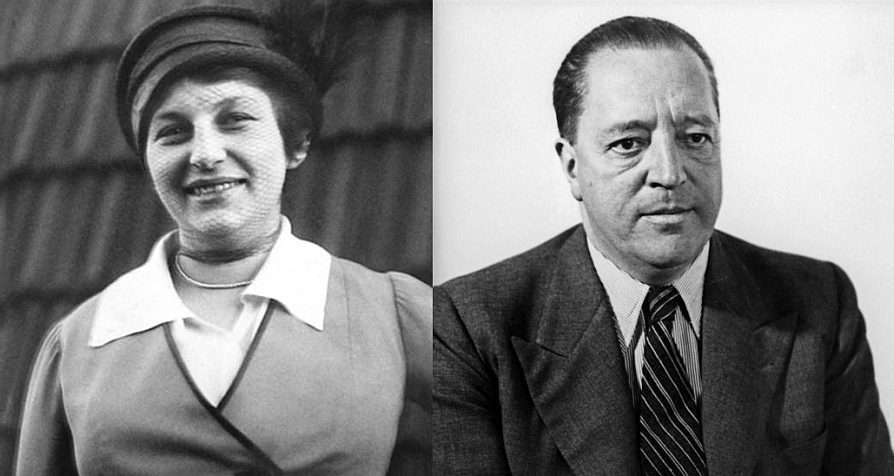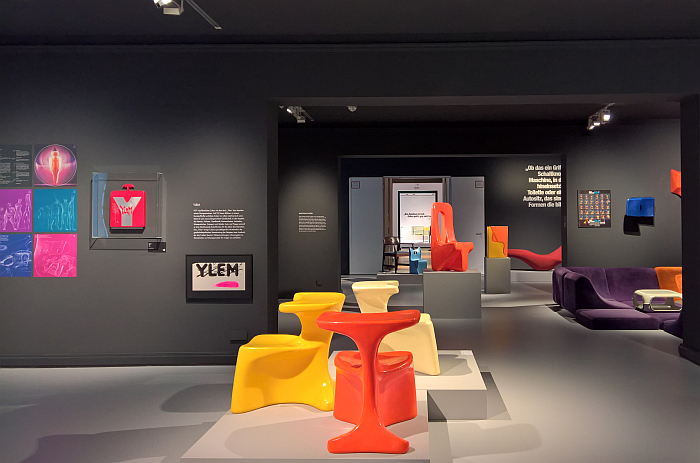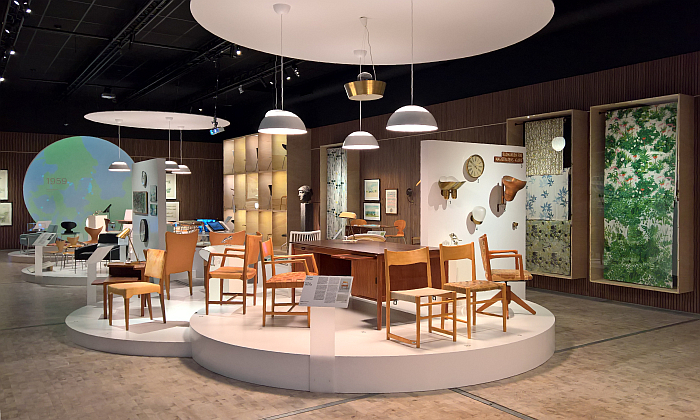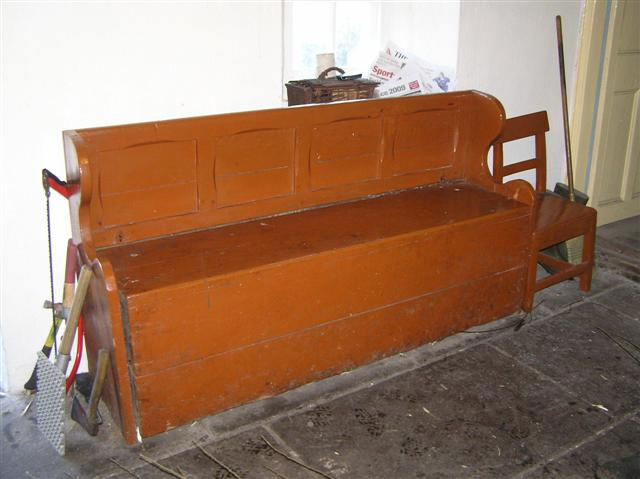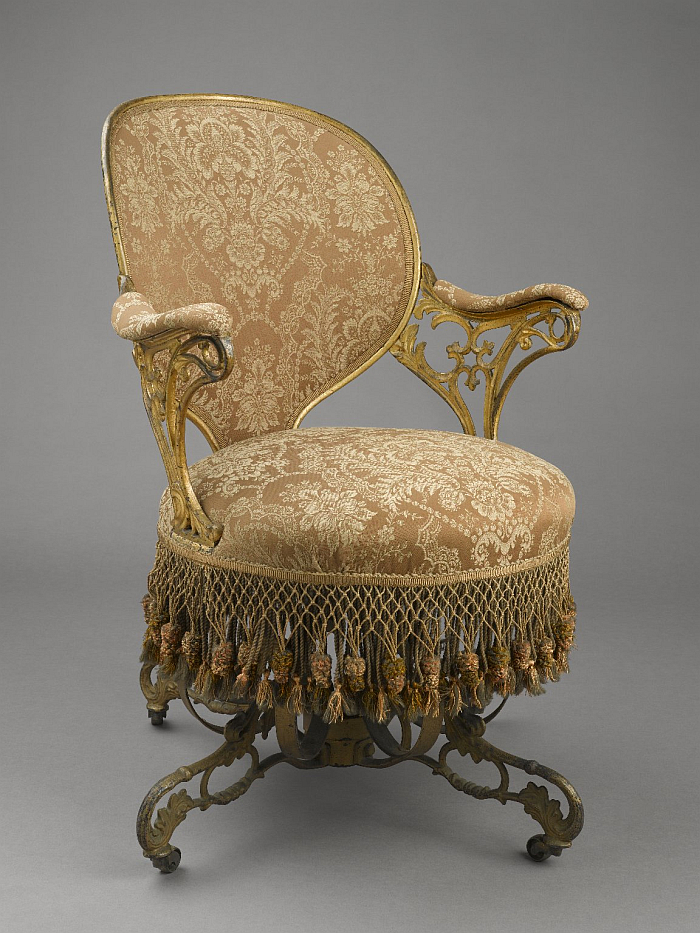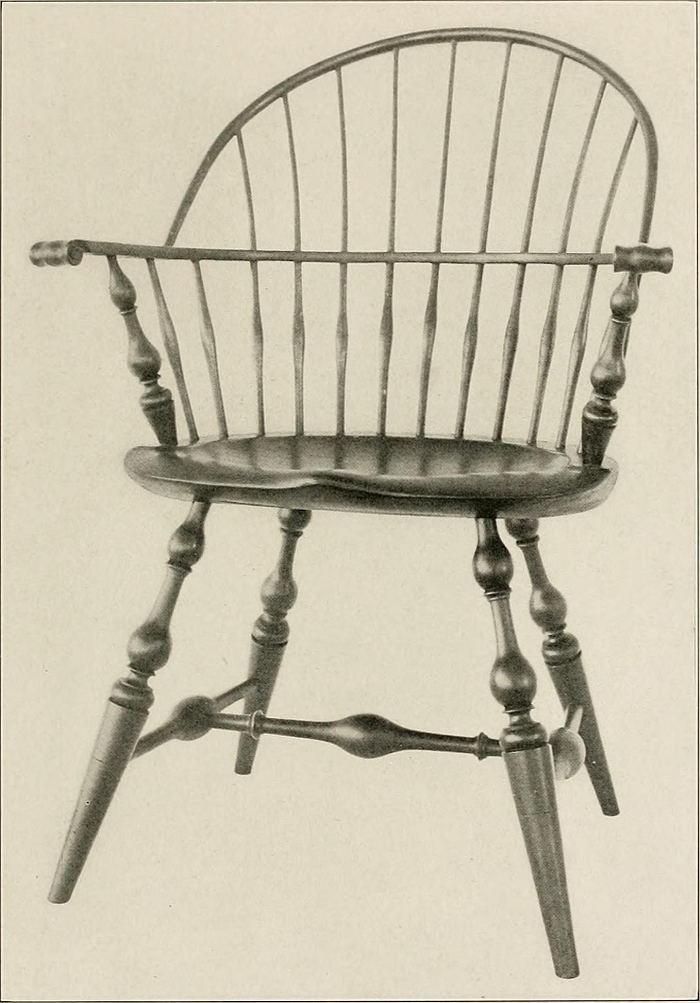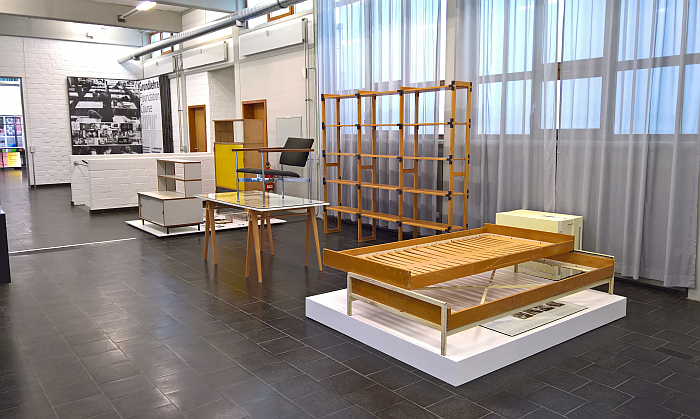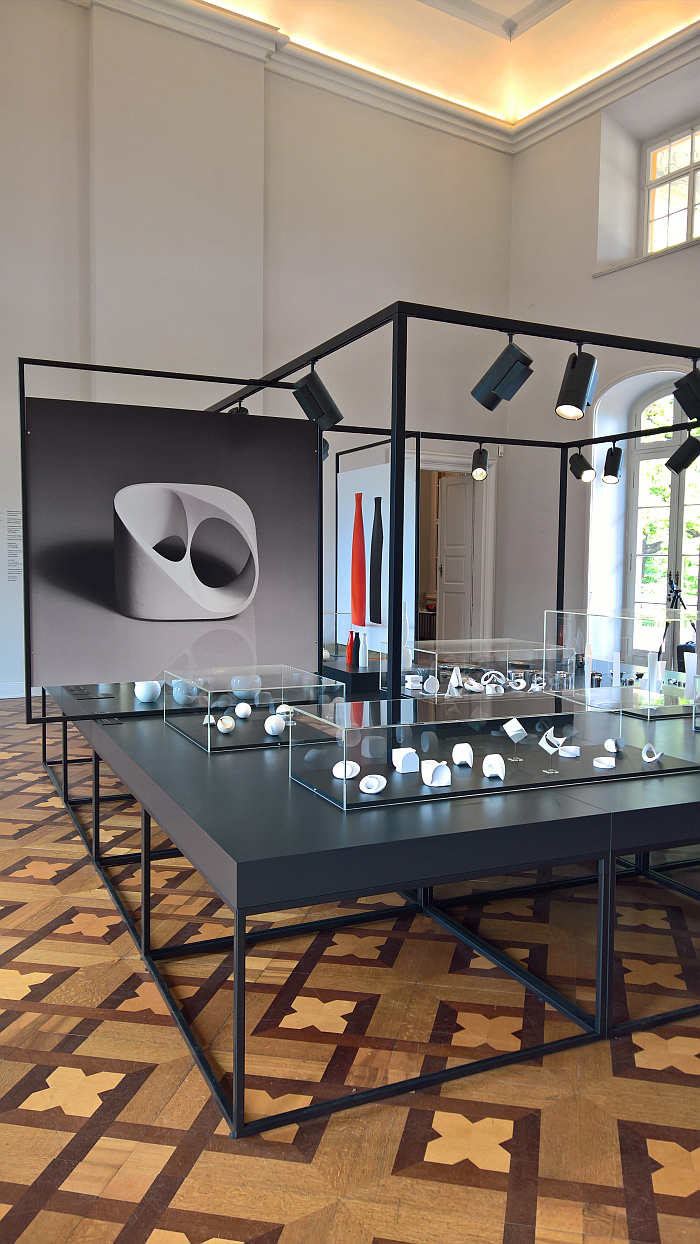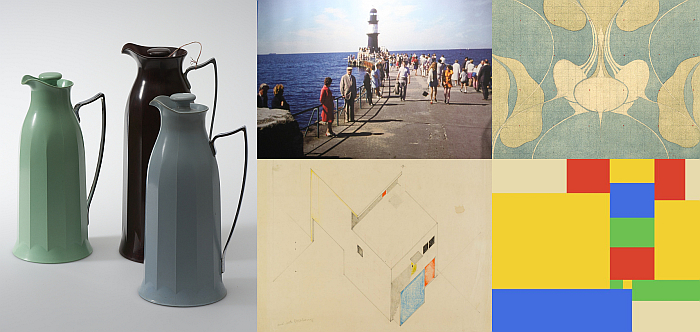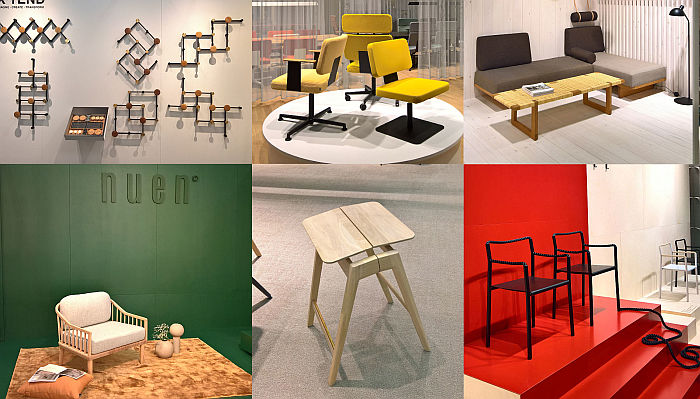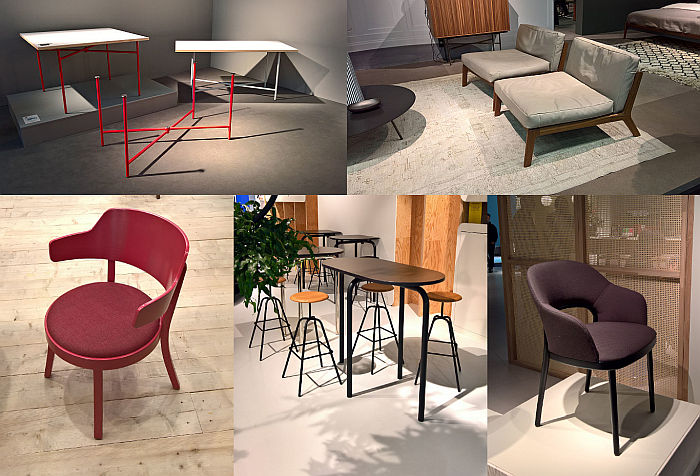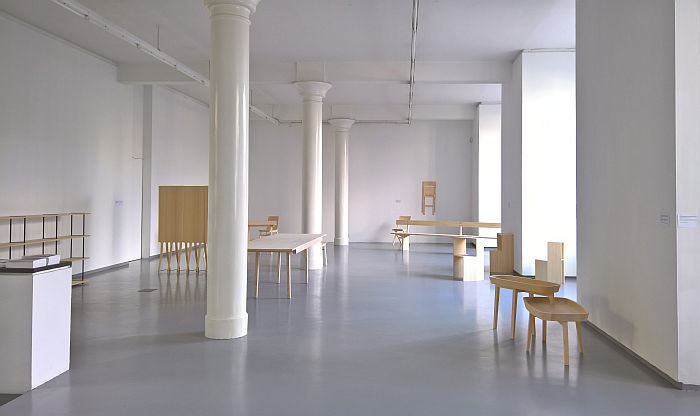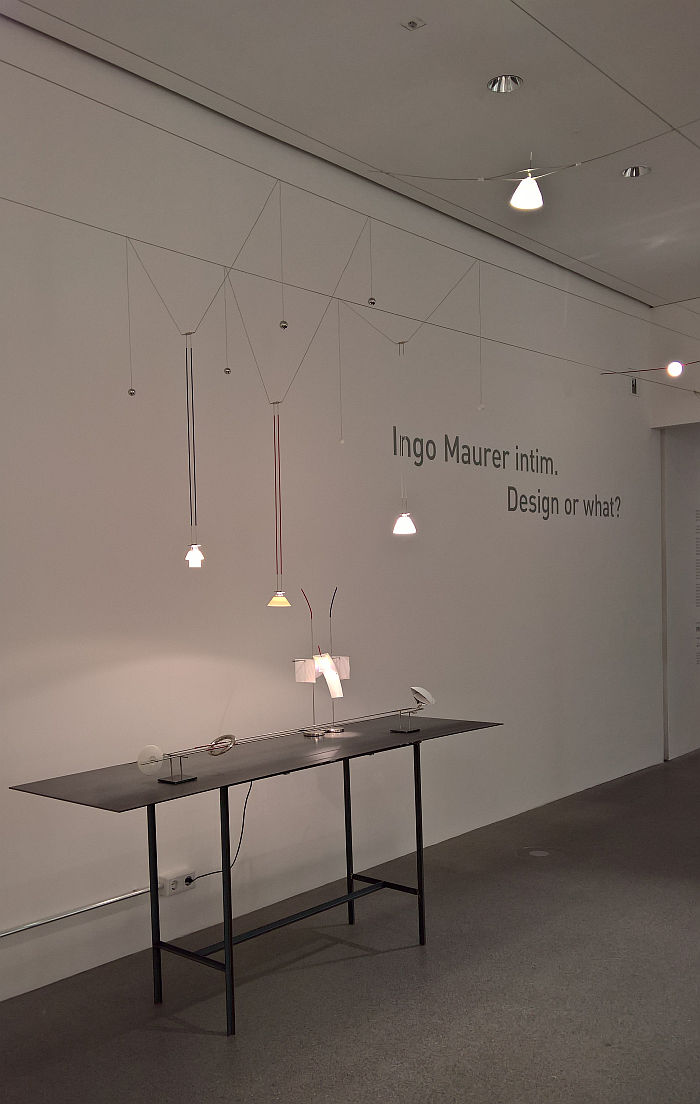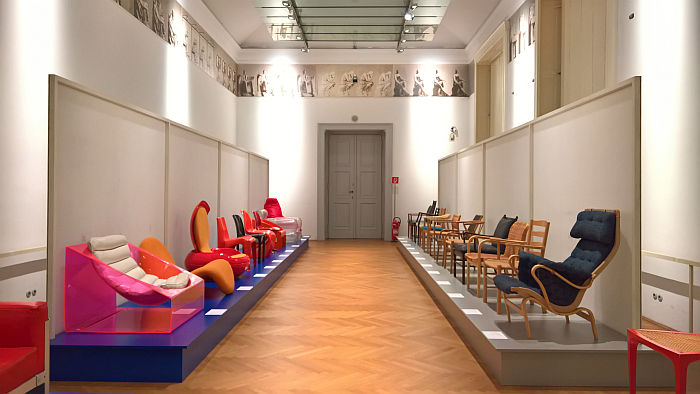Category: Product
Memphis: 40 Years of Kitsch and Elegance at the Vitra Design Museum Gallery, Weil am Rhein
Much as with “Bauhaus”, “Memphis” is all too often popularly reduced to a “style”, something one can “recreate”.
As with “Bauhaus” that it is not only disingenuous, and erroneous, but hinders development of understandings of the (hi)story of design, understandings of the path taken to our contemporary design that are important for considerations on where we are and how best to progress.
With the showcase Memphis: 40 Years of Kitsch and Elegance the Vitra Design Museum Gallery issue an invitation for us all to delve a little deeper, to look below the plastic laminated surface.
Braun 100 at the Bröhan-Museum, Berlin
Braun occupy a special, ¿unique?, position not only in the mythology of product design but also in the (hi)story of West Germany; arguably no brand is as closely related with and to West Germany as Braun.
With the exhibition Braun 100 the Bröhan-Museum, Berlin, explore the development of design at Braun in the post-War decades and in doing so help one approach differentiated understandings of not only Braun and Braun design, but also of the relationships between Braun, design and West Germany…….
Simson, Diamant, Erika. Formgestaltung von Karl Clauss Dietel at the Kunstsammlungen Chemnitz
“In his work the designer seeks to find the constancy of the good”, wrote Karl Clauss Dietel in 1973, a lightly articulated yet not so straightforward task for, as he continues, not only is the assessment of such dependent on a myriad varying factors, but “the search for what defines design, what it grows from, where it comes from and where it wants to go, takes on new dimensions against the background of our cultural upheaval”.1
With the exhibition Simson, Diamant, Erika. Formgestaltung von Karl Clauss Dietel the Kunstsammlungen Chemnitz allow insights into not only how Karl Clauss Dietel understood “what defines design, what it grows from, where it comes from and where it wants to go” but how those understandings aided and abetted him in his own search for, understanding of, “the constancy of the good”…….
5 New Architecture & Design Exhibitions for June 2021
“I wonder what it would be like to live in a world where it is always June”, ponders Anne Shirley in Lucy Maud Montgomery’s 1915 novel Anne of the Island.
“You’d get tired of it”, sighs her adoptive mother Marilla Cuthbert by way of reply.
“I daresay”, responds Anne, “but just now I feel that it would take me a long time to get tired of it…”
Thoughts we very much concur with as we survey and contemplate the varied profusion of new architecture and design exhibitions sprouting forth in June 2021. Who could ever tire of such a joyous abundance? Who?
Our five recommendations from that early summer crop can be found in Leipzig, Hornu, Berlin, Bloomfield Hills and Chemnitz…….
smow Blog Design Calendar: May 25th 1895 – Happy Birthday Clara Porset!
“¿Qué es diseño?” asked Clara Porset in 1949. What is design?1
Not because she didn’t know. Far from it. Over the course of the preceding two decades Clara Porset had ably demonstrated her considered, critical and responsive understandings of design; understandings that saw her develop into one of the most important, interesting and informative furniture designers in Mexico, understandings that saw her develop into one of the more important, interesting and informative protagonists in the development of industrial design in Mexico.
Before she slipped from view and into the (relative) anonymity she finds herself today.
Before the more pertinent question became, ¿quién es Clara Porset?
5 New Architecture & Design Exhibitions for April 2021
As the 19th century English poet Robert Browning so very, very, nearly phrased it:
Oh, to be in Berlin, Vienna, Chemnitz, ‘s-Hertogenbosch, or Berlin (again),
Now that April’s there,
And whoever wakes in Berlin, Vienna, Chemnitz, ‘s-Hertogenbosch, or Berlin (again),
Sees, some morning a most interesting, entertaining and instructive sounding architecture and/or design exhibition,
While the chaffinch sings on the orchard bough……
Design. Colour. Theory.: Verner Panton – Lidt om Farver/Notes on Colour
“One sits more comfortably on a colour that one likes” declares Verner Panton in his 1997 book Lidt om Farver/Notes on Colour.1
A succinct expression of an understanding of colour as more than just a decorative element, and one of many reflections on the function and relevance of colour beyond the merely decorative which, in a myriad guises, pervade the history of furniture and product design.
And contrasting, if at times complementary, reflections, pun intended, we will consider in the coming weeks and months via a selection of texts and pronouncements from a contrasting, if at times complementary, collection of international creatives. And while not all the sources considered represent theories in a classic understanding of the term, and certainly not colour theory in a classic understanding; in representing the respective creative’s understandings of the relationships between colour and form, colour and function, colour and user, colour and artistry, etc, can be considered as contributions to the development of a more formal design.colour.theory..
We start with Verner Panton and Lidt om Farver/Notes on Colour……
smow Blog Design Calendar: January 25th 1894 – Happy Birthday Aino Aalto!
In 1936 Aino Aalto opined that “homes can be given interior design in other ways than before – not by buying expensive complete suites of furniture, but by concentrating on low-cost furnishings which can be used – with the aid of flowers, carpets, drapery and colours – to create hitherto more practical and more comfortable homes.”1
A break not only with the understandings, the ways, of generations long past in terms of what constitutes appropriate furniture; but also a break with the ways of many of the functionalist modernist practitioners of the immediately preceding decade in terms of what constitutes an interior design.
And an opinion, an understanding, which underscores why Aino Aalto stands as an important moment in the (hi)story of interior and furniture design…..
Radio smow: A Candlesticks Playlist…….
In the northern hemisphere* December marks not only the darkest period of the year but also that moment when light begins to return: following the Winter Solstice our days start to get a little longer, and a little brighter.
And in December 2020 not just astronomically, but metaphorically.
Midwinter 2020 symbolising a moment when a particularly dark year, a particularly dark period, starts to get a little brighter, a moment when a little more light will start to slowly seep into our days, weeks, months, lives: and not just because of that, but also; nor just because of that, but also; and, yes, also because of that. But definitely not because of that.
And so by way of celebrating a particularly notable Midwinter, a Radio smow playlist devoted to one of the earliest objects to make artificial light manageable and functional, and thus one of the earliest objects to literally bring a little more light into our lives, to literally aid making our lives a little brighter…….
A World of Vernacular Furniture: The Orkney Chair
The study of vernacular furniture can teach us a lot about not only the development of understandings of furniture, nor only of the development of societies and cultures, nor nor only only about relationships between furniture and wider realities, but also how the position of furniture as a cultural good, as a good embedded in a culture and society, can see furniture serve as a component of projected understandings of heritage and identity, and in doing so can endow attributes on an object of furniture it doesn’t naturally, inherently, possess.
Or need.
Something particularly well expressed in the (hi)stories of the straw-backed chair, a.k.a. the Orkney Chair1
Enzo Mari curated by Hans Ulrich Obrist with Francesca Giacomelli at the Triennale Milano, Milan
“I don’t know what design is”, opined once the Italian designer Enzo Mari.
Not because he hadn’t considered the question. But because he had. A lot.
With the exhibition Enzo Mari curated by Hans Ulrich Obrist with Francesca Giacomelli the Triennale Milano present an opportunity to approach an understanding of that which in the course of those considerations, and his 60+ year career, Enzo Mari has variously understood both design to be, and what it could, should, must, be……..
The Furniture of Lilly Reich and Ludwig Mies van der Rohe: The Early Years
In 1977 Ludwig Glaeser, curator of the Mies van der Rohe Archive at the Museum of Modern Art, New York, opinioned that “it is certainly more than a coincidence that [Mies van der Rohe’s] involvement in furniture and exhibition design began in the same year as his personal relationship with Lilly Reich.”1
A statement that has in many regards come to define understandings of the furniture designs of both Ludwig Mies van der Rohe and Lilly Reich.
An understanding that “is certainly more than a coincidence”. It is wrong. Certainly in terms of furniture design.
And a statement and understanding whose clarification not only provides an excellent starting point for an exploration of the furniture designs of Lilly Reich and Ludwig Mies van der Rohe, but also for some reflections on the (hi)story of furniture design……..
Luigi Colani and Art Nouveau at the Bröhan-Museum, Berlin
In 1977 the German designer Luigi Colani demanded a “renaissance of Art Nouveau”1
What he meant, why he meant it, and if it is something we should all fear, can be explored and considered in the exhibition Luigi Colani and Art Nouveau at the Bröhan-Museum, Berlin…….
Arne Jacobsen – Designing Denmark at Trapholt, Kolding
“Hvis jeg får et nyt liv, vil jeg være gartner“, opined once the Danish architect and designer Arne Jacobsen.
“If I have another life, I want to be a gardener”
Not that, as Arne Jacobsen – Designing Denmark at Trapholt, Kolding, would tend to imply, he made an incorrect career choice…..
A World of Vernacular Furniture: The Settle Bed
“Trunk-hasped, cart-heavy, painted an ignorant brown.
And pew-strait, bin-deep, standing four-square as an ark”1
Reading Seamus Heaney’s musings on his Settle Bed one could be forgiven for considering it a thoroughly unremarkable object. Ignorant even.
That would however be to misunderstand the nature, spirit, essence, of poetic construction. And the nature, spirit, essence of the Settle Bed.
#officetour Milestones – Centripetal Spring Chair by Thomas E. Warren
While understandings of form, of beauty, in context of the objects with which we surround ourselves continually evolve and develop, understandings of function are, generally, much more stable. Or at least are once they have been identified, understood and normalised.
Something that can be studied and appreciated in Thomas E. Warren’s Centripetal Spring Chair…..
A World of Vernacular Furniture: The Windsor Chair
In all corners of the globe one finds objects of furniture which developed in response to local conditions, traditions and practices; vernacular objects without a formal author and which although, on account of?, arising from a very specific place and time can, invariably, both teach us a lot about the essentials of furniture and help explain furniture’s relationships with wider realities.
And objects we want to celebrate, starting with arguably, one of the best known examples of vernacular furniture: the Windsor chair.
Hans Gugelot. The Architecture of Design at the HfG-Archiv, Ulm
The German designer and graphic artist Otl Aicher once opined, “Hans Gugelot wasn’t a theoretician. But not a practitioner either. What is one if neither a theorist nor a practitioner?”1
What, indeed…..?
With the exhibition Hans Gugelot. The Architecture of Design the HfG-Archiv Ulm allows one to approach an answer…..
Beauty of Form. The Designer Christa Petroff-Bohne at the Kunstgewerbemuseum Dresden
Christa Petroff-Bohne arrived a trifling couple of minutes late for the opening of Beauty of Form.
And was most apologetic, apologised for keeping us all waiting.
Whereby, we couldn’t help thinking, it is much more us, all, the international community, who should be apologising for keeping Christa Petroff-Bohne waiting for such a comprehensive and rounded recognition of her work and career………1
5 New Architecture & Design Exhibitions for July 2020
July is traditionally a slow month for new architecture and design exhibition openings. July 2020 less so. Not because of any fundamental changes in understandings amongst architecture and design museums of when is a good time to open an exhibition; but because owing to Corona many shows scheduled to open in the spring had to be postponed, not least until the museums were allowed to open.
And throughout July 2020 ever more museums are planned and planning to open; meaning ever more architecture and design exhibitions are planned and planning to open throughout July 2020.
And thus, while our physical travel options may still be limited, our (potential) cerebral and cultural travel spheres continues to expand, and that is never a bad thing.
If you do feel comfortable about visiting a museum, and are physically allowed to do so, as we will never tire of saying in these trying of times, please familiarise yourself in advance with the current ticketing, entry, safety, hygiene, cloakroom, etc rules and systems.
And during your visit please stay safe, stay responsible, and above all, stay curious….
Stockholm Furniture Fair 2020: High Five!!
With the 2020 edition Stockholm Furniture Fair celebrates its 70th birthday.
Grattis på födelsedagen!
We did think about taking along a cake, but knew the halls of Stockholmsmässan would be filled to the rafters with Kanelbullar, as indeed would we.
And so by way of a present, a Stockholm Furniture Fair 2020 High 6!!
IMM Cologne 2020: High Five!!
Apart from the chance to peruse and consider the collections and new products of and from a wide variety of manufacturers and labels, one of the real joys of visiting any furniture fair is the opportunity it allows to observe designers in conversation with manufacturers and labels. For all in pairings that currently don’t formally exist. We never eavesdrop on such conversations, that would be rude, and to overplay our prowess as spies; but we do enjoy imagining what may arise from those conversations, imagining the enthralling objects and brave new world that awaits us all.
A brave new world that far from being a refuge from our contemporary world in many regards helps sharpen our focus on the contemporary world that surrounds us, the collections and new products of and from a wide variety of manufacturers and labels laid out for our consideration and perusal.
New products that may have begun as an informal conversation on a trade fair stand. And now look where that’s developed…..
And so, and with our customary caution that we have invariably missed one or the other gem, which in this case we know we did, but which we plan to make up for later, an IMM Cologne 2020 High Five!!
Passagen Cologne 2020: Generation Köln trifft Bregenzerwald
In our post from the exhibition Design Gruppe Pentagon at the Museum Angewandte Kunst Cologne we noted that Gallery Pentagon was laterally based in Cologne’s Bismarckstrasse. Bismarckstrasse 50 to be precise, a former cardboard packaging factory which in the 1980s was developed into spaces for creatives of various ilks…..
…..Bismarckstrasse 50 is still home to creatives of various ilks, and is still home to a gallery, Galerie Martina Kaiser, where in context of the 2020 Passagen Interior Design Week a new generation of Cologne designers are presenting new projects, projects raised not in the agitations, turmoils and transformations of 1980s West Germany that informed the Pentagonia’s works, but rather in the calm, alpine forests of Austria’s Bregenzerwald.
Yet objects no less expressive for the change of air…….
Ingo Maurer intim. Design or what? Die Neue Sammlung – The Design Museum, Munich
In context of the 2013 exhibition Lightopia at the Vitra Design Museum a point of particularly intense illumination, pun intended, was the difference between light and lighting, and that the craft of the lighting designer is to bring a tangible form to an intangible material.
With the exhibition Ingo Maurer intim. Design or what? Die Neue Sammlung – The Design Museum Munich celebrate, and remember, one of Germany’s leading designer’s of light…..
Sitzen 69 Revisited @ MAK – Museum für angewandte Kunst, Vienna
“Since the founding of the museum in 1864 there has been an ongoing committent to honouring the statute of the house, namely, to promote the art industries and the arts and crafts and to develop the taste of contemporary society”1
So noted the, then, Österreichisches Museum für angewandte Kunst’s Director Wilhelm Mrazek in the catalogue to the museum’s 1969 exhibition Sitzen 69, Sitting 69, an exhibition which sought “to develop the taste of contemporary society” in terms of sitting/seating.
And that through a presentation of (largely) wooden chairs, several of which dated back to the 1930s and 1940s………
…….in 1969.
?????????
With the showcase Sitzen 69 Revisited the, now, MAK – Museum für angewandte Kunst initiate a debate on the apparent contradictions inherent in Sitzen 69, and on the wider question of the mediation of design, through a presentation of objects presented in 1969 juxtaposed with some of those chair designs that weren’t. Chair designs that one may have, reasonably, expected should, would, have been……
